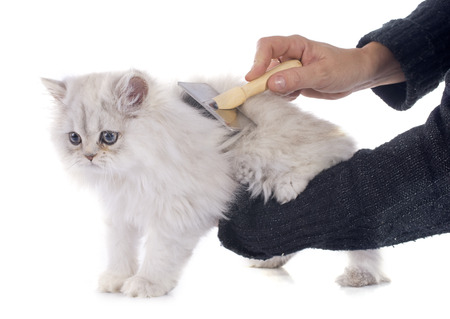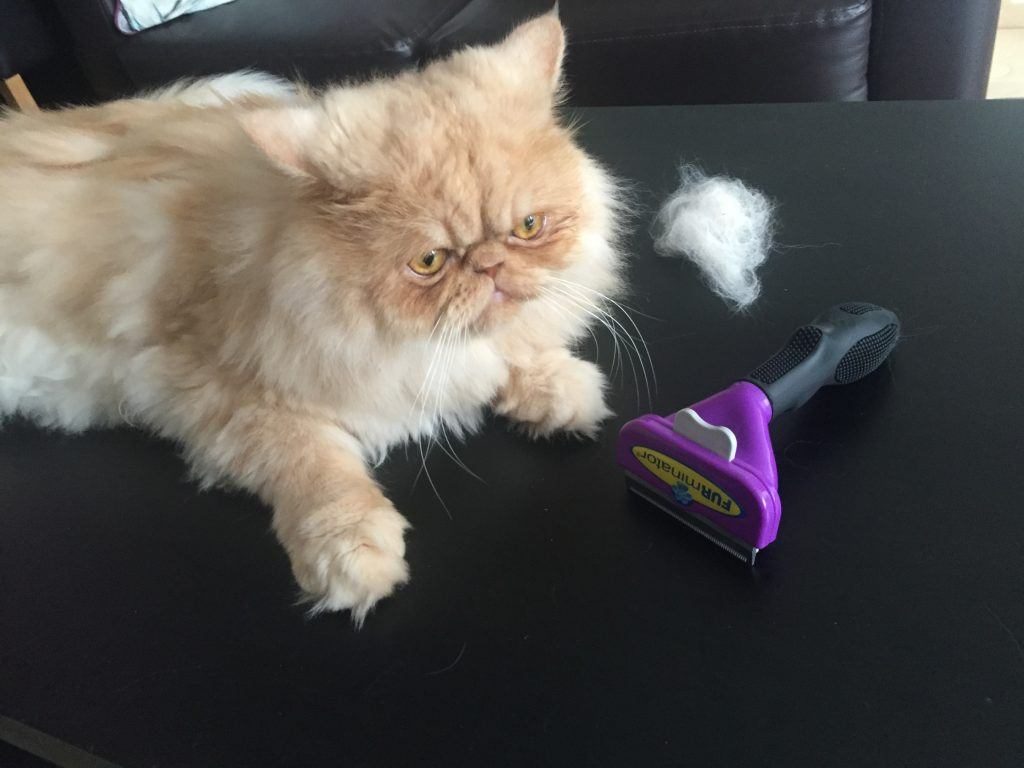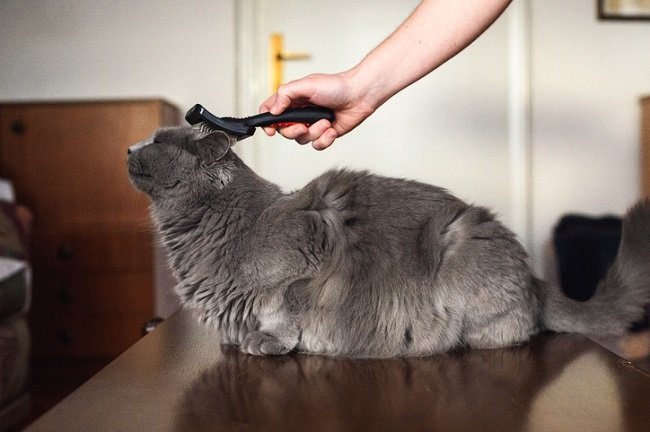Even though some cats shed more heavily than others, all of them shed.
Cats that are adapted for colder climates have a thicker coat and are therefore heavier shedders than those that live in warmer climates.
For this same reason, how much the cat sheds will most likely depend on the season.
Shedding is a natural process through which the cat sheds the old coat to give room for a new one to grow.
If you don’t deshed your cats, they will do it themselves. Since they do this by licking themselves, they will inevitably swallow some loose hair.
These loose hairs can accumulate and form hairballs inside the gut.
In a best-case scenario, the cat will regurgitate the hairball.
But if the hairball is too big, it will get trapped in the intestinal tract and block it which could be fatal.
This underscores the importance of deshsedding your cat regularly.
Let’s look at some of the easy ways to deshed your cat.
1. Deshed By Brushing Or Combing

Brushing is the most practical way of deshedding your cat.
It helps to remove the old fur before it falls off.
You should brush your cat regularly to achieve the best results.
By so doing, you will have less cat hair to worry about in your house.
If your cat has a thick coat, you may also want to comb him regularly.
The more often you brush and comb your cat, the less likely he will shed.
The following are some tools you can use for brushing your cat.
- Sticker brushes: These are typically rectangular-headed and they have fine metal tines
- Wide-toothed combs: They can be metallic or plastic as long as they have widely separated teeth
- Rubber Brushes: As the name suggests, these are brushes that have rubber tines. They are ideal for cats with soft fur.
- Bristle Brushes: These are the commonest types of brushes and their bristles could be either synthetic or natural.
- Pin Brushes: Pin brushes are somewhat identical to bristle brushes except that they have metal and wood instead of natural or synthetic bristles.
- Blade-On-A-Handle Metal Combs: These are ideal for medium and plush-coated cats because they have narrow teeth that reach for the fine undercoat while leaving the overcoat undisturbed.
2. Deshed By Bathing
Giving your cat a nice wash is another sure way of deshedding him.
Washing the cat will get rid of the loose fur and remove any debris on the skin that might pull the fur out.
It also ensures your cat is clean to avoid any parasites that like dirt and germs.
As a rule of thumb, wash your cat with cat shampoo every fortnight. If your cat gives you a hard time in the sink, use disposable wipes, a wet cloth, or a water spray.
3. Deshed Through Proper Diet
Even though desheding is a natural process, some factors might exacerbate it.
For instance, a sick cat will shed more than a healthy cat.
Feeding your cat well is a great way of ensuring good health and thereby preventing unnecessary shedding.
A cat that has been fed well will have healthy smooth skin that doesn’t shed a lot.
Make sure to give your cats foods that are rich in Omega-3 and omega-6 fatty acids as they are good in softening the fur of the cat and reducing shedding.
How Often Should A Cat Be Deshed?

If you don’t deshed your cat, nature will take its cause and the cats will shed on your sofa, bed, carpet or anywhere they please in your house—and that can be such a nuisance.
To avoid dealing with this, it is advisable to deshed your cat once or twice a week.
Grooming should be a pleasant experience for your cat. One way of ensuring this is to introduce it early.
If you have kittens, start grooming them early. This will help them get accustomed to it and they will give you less trouble in their adulthood.
You may also want to be gentle and use a brush that is comfortable for the cat.
Do not try to force the grooming though – if the cat resists, there is a good chance they are uncomfortable.
You can try changing your brush or offering them treats to encourage them to go through with it.
Once you find a routine that works, stick to it and groom your kitty every week.
There are lots of advantages to desheding your cat every week. These include:
- Removing coat sheds and thereby protecting your kitty from skin irritations and allergens
- Keeping your home, car, and clothes free from cat hair
- Deshedding regularly removes loose hair from the undercoat and this prevents the cat from eating it which could cause hairballs
- Regular desedding stops mat formation below the topcoat of your cat.
Is There A Deshedding Treatment For Cats?

Deshedding is not an illness and it, therefore, doesn’t have a treatment.
Cats deshed over time to allow for the regeneration of their coat.
However, you can reduce excessive shedding by using specialized cat shampoo.
You want to get a shampoo that doesn’t contain chemical dyes or parabens .
For best results, go for a shampoo that has been enriched with plant proteins and omega fatty acids.
But the shampoo should not be thought of as an all-in-one solution. You will still need to brush your cat regularly and feed him well to keep the shedding in check.
And if you believe the shedding is out of control, take your cat to the vet for a checkup to rule out any underlying illnesses.
How to Use a Shedding Blade on a Cat
Shedding blades were traditionally used for horses and goats but they can also be used for cats.
Obviously, the blades to use on cats are much smaller. A shedding blade is usually blunt and shaped like a U and it typically has leather handle although plastic and other types of handles can be used.
On one side of the blade, there are dulled teeth that are used for catching and removing any loose hairs from the coat.
Shedding blades are ideal for cats with shorter coats though you can still use them on longer-coated cats but they will not be very effective.
Using a shedding blade requires some skill—if you press too firmly, you will irritate the skin of your kitty.
You want to keep a light touch to avoid hurting your cat or causing their skin to be dry and flaky.
Once you start using a shedding blade, you may want to pay close attention to your cat’s skin.
If they start scratching or showing irritation, switch to a gentler blade or start going easier on your blade.
You may also want to use the shedding blade outdoors as it may remove lots of loose hairs which could fly all over your house.
Closing Thoughts
As we have seen, it is a good idea to deshed your cat once or twice a week depending on how thick of a cat your cat has.
Try to deshed your cat outdoors but if you can’t do it outside because of weather or another reason, remember to vacuum the house once you are done.
Deshedding not only keeps your cat healthy but also helps you to prevent the cat from shedding on your couch, bed, carpet, or clothes.

Hi! I am Eleanor Price. I started this website after my cat, Louie, almost died from a case of botulism (a type of food poisoning often caused by bacteria that grow on food items). Turned out that my cat’s diet was the problem. I have made it my duty to provide the best information and recommendations about everything cat lovers need to know about their felines’ health and wellbeing. My goal is to find the most informative content on anything feline-related and share it with fellow hardworking kitty lovers.


